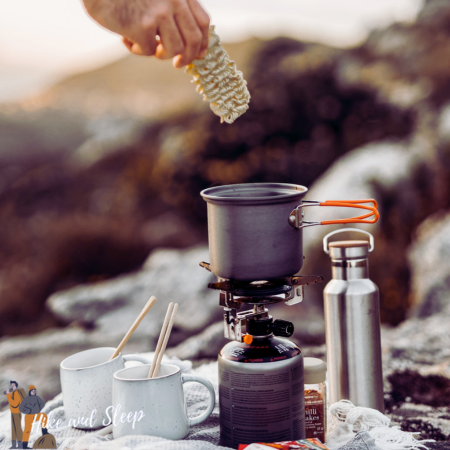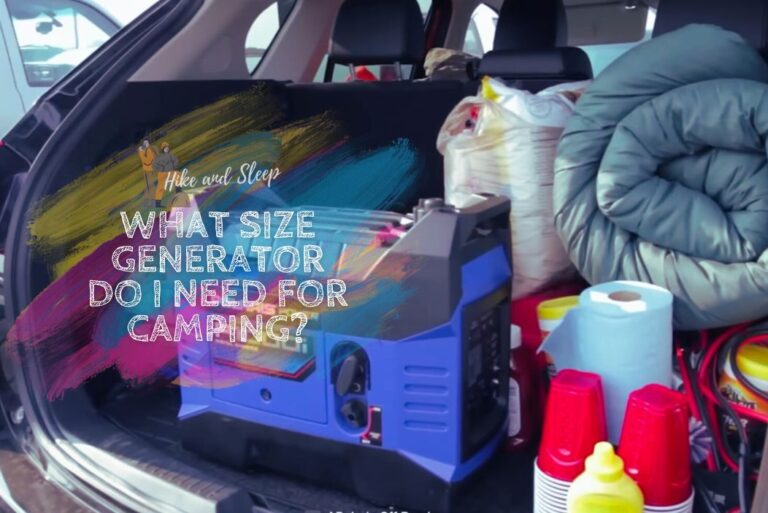Can you use a camping stove indoors? A Comprehensive Guide
A dependable camping stove is crucial for outdoor adventures and camping holidays. It enables you to create delectable meals even when you’re out in the bush. However, there may be situations where you wonder if you can use a camping stove indoors.
Generally, the answer is yes but it is advisable to not use it. The purpose of this article is to provide a full reference on using camping stoves indoors, including safety problems, guidelines, and alternative options.
Table of Contents
- 1 Can You Use a Camping Stove Indoors?
- 2 Types of Camping Stove fuels:
- 3 Safety Precautions and Guidelines
- 4 Our Top Picks
- 5 Alternatives to Using a Camping Stove Indoors
- 6 Conclusion
- 7 FAQs
- 7.1 Can you use a propane camping stove indoors?
- 7.2 What is the best way to cook indoors while camping?
- 7.3 Are there camping stoves designed for indoor use?
- 7.4 Can you use a camping stove in a well-ventilated area indoors?
- 7.5 Are there any portable camping stoves that can be used indoors?
- 7.6 Can you use a camping stove indoors in an emergency?
Can You Use a Camping Stove Indoors?
Using a camping stove indoors is generally not recommended due to safety hazards. Even though camping stoves are designed for outdoor use, some people may consider using them indoors in emergencies or when conventional cooking appliances aren’t available. However, it’s critical to understand the risks of using a camping stove indoors.
Indoor use of a camping stove poses a major health risk from carbon monoxide (CO) poisoning. Camping stoves emit CO gas when used in a confined setting, which can be hazardous.
High quantities of carbon monoxide in the air can cause headaches, nausea, dizziness, confusion, and even death.

Types of Camping Stove fuels:
Propane:
Propane is a versatile and popular camping stove fuel known for its convenience and efficiency. It is a clean-burning gas with a continuous flame, making it excellent for outdoor cooking activities. Propane burners are small and convenient, and they can swiftly heat up your favorite camping foods. Propane is safe to use outside, but it should not be used inside. When propane burns, it emits carbon monoxide (CO), which is extremely dangerous to breathe in tight settings. To ensure your safety, always use propane stoves in well-ventilated areas to allow the harmful gases to disperse.
Butane:
Butane is a popular camping stove fuel that is quite comparable to propane. It is a clean-burning petrol that is convenient and portable, making it a popular choice among campers. Butane canisters are lightweight, portable, and provide a consistent heat source for cooking. Nevertheless, like propane, Butane should never be used indoors due to the possibility of carbon monoxide poisoning. When utilizing butane stoves, it’s essential to have enough ventilation because the combustion process creates hazardous fumes that must be expelled into the outside air.
Alcohol:
Alcohol stoves are lightweight, compact, and widely used by backpackers and hikers. They operate by burning denatured alcohol or high-proof spirits, such as ethanol. Alcohol stoves are well-liked for being straightforward and simple to use. Due to the low amounts of hazardous emissions, they are typically regarded as safe for outdoor use. However, due to the risk of fire, it is not advised to use alcohol stoves indoors. Alcohol flames can be hard to see, making it easier to accidentally ignite nearby flammable objects. It’s always best to use alcohol stoves in open spaces away from any potential fire hazards.
Kerosene:
Kerosene is a liquid fuel commonly used in portable camping stoves and lanterns. Longer camping trips are appropriate because of their high energy content and long burn periods. However, using kerosene stoves indoors is strongly discouraged due to several reasons. For starters, when paraffin is burned, it emits carbon monoxide, which is hazardous to your health in enclosed environments. Furthermore, kerosene stoves can produce soot and emit unpleasant odors, which can quickly collect and degrade indoor air quality. To ensure safety, always use kerosene stoves in well-ventilated areas and avoid using them indoors.
Wood:
Cooking over an open fire with wood is a traditional and enjoyable way to prepare meals while camping. Wood fires create a cozy atmosphere and add a natural flavor to your food. However, using wood as a fuel indoors can be hazardous. When wood is burned, it emits carbon monoxide, particulate matter, and other dangerous gases. In confined locations, these emissions can quickly accumulate, causing health concerns or even carbon monoxide overdose. It is better to cook with wood in open spaces, away from buildings, and with adequate ventilation to enable the safe dispersal of smoke and fumes.
Charcoal:
Because it produces a lot of heat and imparts a smokey flavor to food, charcoal is a common fuel source for grilling and barbecuing. Charcoal briquettes are easy to ignite and provide a consistent heat source. However, using charcoal indoors, whether in a camping stove or a charcoal grill, is strongly discouraged. Carbon monoxide, an odorless and colorless gas that can be lethal if inhaled in high quantities, is produced when charcoal is burned. Furthermore, charcoal emits a substantial amount of smoke, which can quickly fill enclosed places and pose a health risk. For your safety, reserve charcoal cooking for outdoor use, ensuring ample ventilation and keeping the grill or stove away from any flammable materials.

Safety Precautions and Guidelines
Follow these safety precautions and guidelines to ensure your safety and the safety of others:
Ventilation is key
If you must use a camping stove indoors, make sure there is proper ventilation. Open windows and doors to allow fresh air to circulate and CO gas to dissipate. Using a fan to increase air circulation is also recommended.
Maintain a safe distance
Keep any combustible objects, such as drapes, furniture, and walls, at least three feet away from the camp stove. This reduces the risk of accidental fires.
Never leave it unattended
Always supervise the camping stove while it’s in use. Accidents can happen rapidly, and prompt action may be required to avoid a potentially harmful situation.
Use carbon monoxide detectors
Install carbon monoxide detectors near the area where the camping stove is being used. These devices can alert you to dangerous levels of CO gas, giving you time to evacuate and seek fresh air.
Follow the manufacturer’s instructions
Read and follow the manufacturer’s instructions for your camping stove. They give critical safety information as well as model-specific guidelines.
Remember that these procedures are intended to decrease the risks involved with using a camping stove indoors, not remove them completely. It’s always safer to use alternative cooking methods indoors.
Our Top Picks
- Gas One Propane Double Burner
- Coleman Triton 2-Burner Propane Camping Stove
- Gas One GS-3400P Propane or Butane Stove
- Camp Chef EX60LW Explorer

Alternatives to Using a Camping Stove Indoors
Instead of using a camping stove indoors, consider these alternative cooking methods:
Electric hot plate
An electric hot plate is a safe and convenient indoor cooking solution. It provides a controlled heat source while avoiding the production of hazardous gases.
Portable induction cooktop
Induction cooktops generate heat using magnetic fields, eliminating the risk of open flames and CO gas. They are useful, safe, and simple to use.
Microwave oven
For reheating or quick meals, a microwave oven is a practical choice. It doesn’t produce any harmful gases and is widely available in most households.
Slow cooker or crockpot
Slow cookers are an excellent choice for preparing meals that require a longer time. They are suitable for use indoors and allow you to enjoy warm and filling meals.
By using these options, you may ensure a safer cooking experience indoors while still enjoying tasty dishes.
Conclusion
While camping stoves are fantastic for outdoor cooking adventures, they should never be used indoors unless specifically designed for indoor use. The risks associated with carbon monoxide poisoning make it essential to prioritize safety when cooking in enclosed spaces.
Instead, opt for alternative cooking methods that are safe and designed for indoor use. Never forget that safety should always come first, especially when undertaking wilderness experiences.
FAQs
Can you use a propane camping stove indoors?
No, it is not safe to use a propane camping stove indoors. Propane stoves produce carbon monoxide gas, which can lead to poisoning when used in enclosed spaces.
What is the best way to cook indoors while camping?
The best way to cook indoors while camping is to use alternative cooking methods such as electric hot plates, portable induction cooktops, microwave ovens, or slow cookers.
Are there camping stoves designed for indoor use?
Yes, there are camping stoves specifically designed for indoor use. These stoves are equipped with safety features like built-in CO detectors and proper ventilation systems. However, they are not as common as outdoor camping stoves.
Can you use a camping stove in a well-ventilated area indoors?
While proper ventilation can help reduce the risks associated with using a camping stove indoors, it is still not recommended. The safest option is to use alternative cooking methods designed for indoor use.
Are there any portable camping stoves that can be used indoors?
Most portable camping stoves are designed for outdoor use only. It’s crucial to check the manufacturer’s instructions and specifications before considering using a camping stove indoors.
Can you use a camping stove indoors in an emergency?
In emergency situations where conventional cooking appliances are unavailable, using a camping stove indoors might seem like an option. However, it’s important to prioritize safety and seek alternative methods whenever possible.
Read Also: Do you need a sleeping bag for camping, Are Yeti coolers worth it



